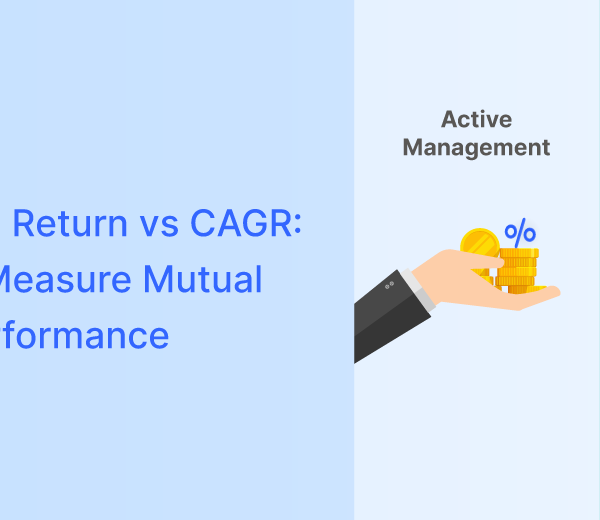Mutual funds have gained immense popularity in recent years due to their simplicity and potential for attractive returns. Among the different mutual fund types, open-ended funds are the most common type of mutual fund through which investors invest.
In this blog, we are discussing how they work, their benefits, and the risks associated with them.
What Are Open-Ended Mutual Funds?
Open-ended mutual funds are a type of mutual fund that allows investors to buy and sell units at any time, based on the current Net Asset Value (NAV). Unlike close-ended funds, which have a fixed maturity period and limited entry and exit points, open-ended funds provide continuous liquidity. This means that investors can enter or exit the fund at their convenience.
How Do Open-Ended Mutual Funds Work?
Like all the other mutual funds, open-ended funds also pool money from multiple investors to invest in a diversified portfolio of securities, like stocks, bonds, or a mix of both. In this fund, investors can redeem or purchase units at the existing NAV on any working day. The NAV is determined by the performance of the fund’s underlying securities.
Open-ended funds are highly liquid. Investors can redeem their units at any time at the prevailing NAV. The mutual fund is obligated to buy back the units from investors, ensuring that your money is accessible when you need it.
Open-ended funds continuously offer new units to investors. This means that the fund size can grow or reduce depending on the number of investors buying or redeeming units.
Open-ended funds are typically managed by experienced fund managers. They make investment decisions based on thorough research and market analysis. The goal is to maximise returns for the investors while managing the associated risks. Fund managers buy or sell securities to meet the investment objectives, which could be growth, income generation, or a mix of both.
What Are The Types Of Investments In Open-Ended Mutual Funds?
Open-ended mutual funds are categorised into different types based on asset class, structure, and speciality.
Asset class-wise, open-ended mutual funds are categorised into:
- Large-cap fund
- Multi-cap fund
- Large and mid-cap fund
- Small-cap fund
- Mid-cap fund
- Contra fund
- Sectoral fund or thematic fund
- Equity-linked savings scheme
- Value fund
Specialty-wise, these funds are categorised into:
- Fund of funds
- Index funds
- Asset allocation funds
- Retirement funds
- Commodity funds or hedge funds
- Children funds
For debt mutual funds, the classifications include:
- Ultra short-duration fund
- Short or medium-duration fund
- Money market fund
- Balanced fund or hybrid fund
- Overnight fund
- Credit risk fund
- Long-duration fund
- Banking and PSU fund
- Corporate bond fund
What Is The Difference Between Open-Ended Funds & Close-Ended Funds?
Below are the differences between close-ended and open-ended mutual funds.
- Open-ended funds offer high liquidity, whereas close-ended ones have no liquidity during the lock-in period.
- You can invest in open-ended funds through SIP or lump sum mode, while close-ended funds allow you to invest during the NFO (New Fund Offer). You can use our SIP and lump sum calculators to calculate the growth potential of your investment amount in less than a few seconds.
- Unlike close-ended funds, open-ended funds allow investors to check track records of schemes’ performances.
- Open-ended funds allow you to take advantage of the rupee cost averaging of unit prices, unlike close-ended funds.
What Are The Benefits Of Open-Ended Mutual Funds?
Open-ended mutual funds offer several advantages. We have mentioned them here.
Liquidity – One of the most significant advantages of open-ended mutual funds is liquidity. Unlike fixed-term investments like Fixed Deposits (CDs) or close-ended mutual funds, investors can enter or exit these funds at any time. If an investor needs quick access to their money, they can redeem their units and receive the payout within a few days.
Diversification – Open-ended mutual funds offer instant diversification. Instead of investing in just one or two stocks or bonds, these funds pool money from multiple investors and invest in a diversified portfolio of assets. This diversification reduces risk, as the fund’s performance is not tied to the success or failure of a single investment.
Professional Management – For investors who lack the time or expertise to manage their portfolios actively, open-ended mutual funds offer the benefit of professional management. Fund managers continuously monitor the market and adjust the portfolio according to market conditions, ensuring that the fund is aligned with its investment objectives.
Flexible Investment Options – Open-ended funds offer flexibility in terms of investment amounts. Investors can start with small investments through SIPs or make lump-sum investments. SIPs allow investors to contribute small amounts regularly, which makes it easier to invest over the long term.
Transparency – Open-ended mutual funds are regulated by the Securities and Exchange Board of India (SEBI). This ensures a high level of transparency as investors can easily access information about the fund’s portfolio, performance, and NAV through periodic disclosures.
What Are The Risks Of Open-Ended Mutual Funds?
Even though open-ended mutual funds offer several benefits, they are not without risks. Here are some potential downsides.
Market Risk – Since open-ended mutual funds invest in market-linked securities, they are subject to market volatility. For example, equity funds are highly sensitive to stock market fluctuations, and their returns can differ based on market conditions.
Expense Ratio – Every mutual fund charges a fee called the expense ratio, which covers the fund’s administrative and management costs. A high expense ratio can eat into your returns over time. So, it is crucial to choose funds with a low expense ratio, especially for long-term investments.
Exit Load – While selling units of mutual funds, a fee is applicable called exit load. This is often a percentage of the unit’s value and can potentially reduce the returns.
What Are The Factors To Consider Before Investing In Open-Ended Mutual Funds?
Investment Objective – Determine your financial goals before selecting a mutual fund. For example, if you are saving for retirement, an equity fund with long-term growth potential may be suitable. However, if you are looking for a steady income, a debt fund might be a better option.
Risk Tolerance – Understand your risk tolerance and choose a fund that aligns with it. Equity funds are suitable for aggressive investors, while debt funds suit risk-averse investors.
Investment Horizon – The time frame of your investment matters. If you have a long-term investment horizon, equity funds may offer better growth prospects. For short-term goals, debt or liquid funds would be more appropriate.
Fund Performance – Always review the historical performance of the mutual funds. However, it is important to understand that past performance is not a guarantee of future returns. Consistency and performance during different market cycles are essential factors to consider.
Expense Ratio – A fund’s expense ratio can considerably affect long-term returns. Look for funds with a lower expense ratio, especially if you plan to invest for the long term.
Open-Ended Mutual Funds – The Conclusion
Open-ended mutual funds are versatile, and flexible, and offer an excellent opportunity for investors to grow their wealth or earn steady income based on their financial goals. Whether you are a risk-taker looking for capital appreciation or a risk-averse investor looking for stability, there is an open-ended mutual fund tailored for you.
If you wish to invest in open-ended mutual funds, you can create a free account with Koshex. Apart from mutual funds, you can also invest in Digital Gold, and track your EMIs, and PF through the app. Manage and grow your money like a professional with the Koshex app today.
Frequently Asked Questions (FAQs)
Are open-ended mutual funds suitable for short-term or long-term goals?
Open-ended mutual funds can be suitable for both short-term and long-term goals, depending on the type of fund. Equity funds are suitable for long-term goals, while liquid or debt funds are better for short-term financial needs.
How is the NAV of a mutual fund calculated?
NAV is the per-unit price of the mutual fund and is calculated by subtracting the mutual fund’s liabilities and expenses from its total asset value and dividing the result by the number of outstanding units. It changes daily based on the performance of the fund’s underlying assets.
How do I track the performance of my open-ended mutual fund?
You can track the performance of your mutual fund through the AMC’s (Asset Management Company) website, online investment platforms, or financial portals that display the NAV, performance reports, and other fund-related updates.









Leave a Comment